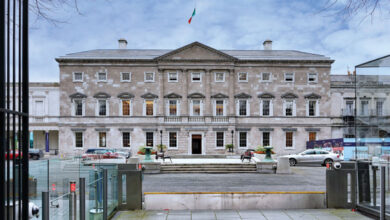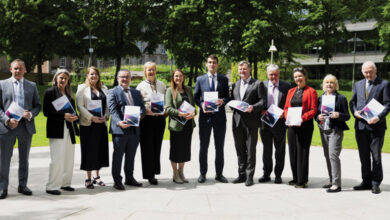National Broadband Plan

The Government has confirmed that an extra €200 million of funding will need to be found for the delayed National Broadband Plan. Originally announced in 2012 with a projected cost of €1 billion, no contract has been signed for the plan yet, with costs projected to come in at around €3 billion.
Making the announcement regarding the necessity for the extra €200 million, Minister for Finance, Public Expenditure and Reform Paschal Donohoe TD said that the money would need to be raised over the next two to three years. He predicted that the funding gap would be covered by tax surpluses providing that the Irish economy grows at 3 per cent per year in that time.
That this announcement came weeks after Eir CEO Carolan Lennon told an Oireachtas committee convening on the matter that her company could still deliver national broadband at a price lower than the original projected cost of €1 billion will have raised eyebrows and questions. Lennon told the committee that her predecessor, Richard Moat, had written to the Department of Communications last January to inform them of this, which in turn prompted the Government to write to Eir to seek clarification on her comment.
Taoiseach Leo Varadkar told the Dáil that the comment represented a “big turnaround” and that the Government wished to ascertain whether or not “this offer is real, if it stacks up”. “We need to know what kind of delay would be imposed on people in rural Ireland waiting for broadband if we went back to a new procurement process,” the Taoiseach said.
Minister for Communications, Climate Action and Environment, Richard Bruton TD said that Eir’s bid was “not a feasible alternative”, while Minister Donohoe has since dismissed the Eir bid, claiming that it doesn’t have the same protections for taxpayers as the bid put forward by the National Broadband Ireland consortium led by American businessman David McCourt that includes Denis O’Brien’s Actavo. Donohoe also said that Eir’s bid would have resulted in the company owning all of the infrastructure used to roll out the plan.
The topic of ownership is one that was raised during the Oireachtas committee chaired by Hildegard Naughton TD, with a draft report by the committee opining that it would be “unfair” for the private National Broadband Ireland to own the network that it will eventually build after the State has invested billions of euro in the plan. As reported by the Irish Times, the draft report called into question “the governance of the broadband plan and the length of time the rollout of the network will take”, and also reported that it had been decided to take a vote on the Fianna Fáil proposal for the Government to “commission an external, independent review around the project’s viability”.
“The joint committee is concerned that, given the amount of the State subsidy for the project is much greater than the initial outlay from the investor, it appears unfair that the resulting network will be owned by the investor rather than the State. This could create the impression that the State is largely paying for the construction of an asset which will be owned by private interests,” the report says, while also protesting the fact that only one member of the National Broadband Ireland board would be appointed by the Government, while eight would be appointed by investors.
Minister Bruton has said that he expects a contract with National Broadband Ireland to be signed before the end of the year, an assertion backed by both Donohoe and Minister of State for Natural Resources, Community Affairs and Digital Development, Seán Canney TD.
Naughton says in her preface to the report that the committee felt it had “no option” but to investigate the process and called on the Government to “get this process right and at the same time not delay the process unduly”. The report states that “the joint committee is unclear as to how that responsibility will safeguard against the board being more concerned with the interests of the consortium, who appoints the bulk of the members, above the State’s interest”.
Also speaking at the committee’s meetings in June, ESB’s Head of Strategy and Innovation, Denis O’Leary, explained the decision for Siro — the consortium of ESB and Vodafone — to pull out of the procurement process in 2017. O’Leary said that the removal of 300,000 people from the plan’s target market and the reduced revenue on offer meant that a business case could not be made for participation in the plan.
“When the 300,000 premises were removed it had a very serious impact on the potential and the projected revenues that they would see over 10, 20, 30 years of the project and that is what made it really challenging,” he told the committee. “Removing such a large number of premises also had a major impact on the design of the network.” He added that it would require months to “repeat the mapping exercise and create a new network design”. The 300,000 homes that were removed from the plan were placed on Eir’s commercial broadband expansion.
The joint committee is concerned that, given the amount of the State subsidy for the project is much greater than the initial outlay from the investor, it appears unfair that the resulting network will be owned by the investor rather than the State. This could create the impression that the State is largely paying for the construction of an asset which will be owned by private interests.
— Oireachtas Communications Committee draft report
The State is now expected to spend €3 billion on the project over 25 years, €2 billion more than was originally planned and Eir’s projected cost for their deliverance of the plan. €545 million of that funding is for contingency plans and legal entitlements for the State to claim should any financial windfall occur from the plan.
It has been reported that those wishing to avail of the broadband provided by the plan will have to pay a one-off fee of €100, which Government officials hope is low enough to encourage uptake. The fibre delivered by the plan to 98 per cent of the premises covered will start with a speed of 150 megabytes per second, rising to 500 after 10 years for residential users.
300 connection points will be installed in the first year in rural towns and villages, acting as hotspots for free WiFi in different communities while the fibre roll out is underway. The Government has said that the 2 per cent of homes that won’t be connected to fibre will be given access to high speed internet through alternative means, such as 5G.
Should the contract with National Broadband Ireland be signed, the consortium will bring in numerous subcontractors to perform the work, including Nokia, whose technology is said to be central to the project; contractors such as the Kelly Group, Actavo and KN Group are already members of the consortium. Seven years after the plan was originally announced, National Broadband Ireland has promised to complete it within seven years, as per their agreement with the Government.
In August, the cross-party Oireachtas communications committee made a series of recommendations that were backed by all parties except Fine Gael. These included:
- a three-month external independent review by an expert of the existing plan, its cost and its tendering process;
- this review should be given the right to recommend a universal service obligation, which would ensure any broadband system remains in public ownership; and
- the review should be allowed to recommend directly awarding a new contract to ESB or Eir to allow either firm to provide broadband at a fraction of the existing cost mooted by National Broadband Ireland.





